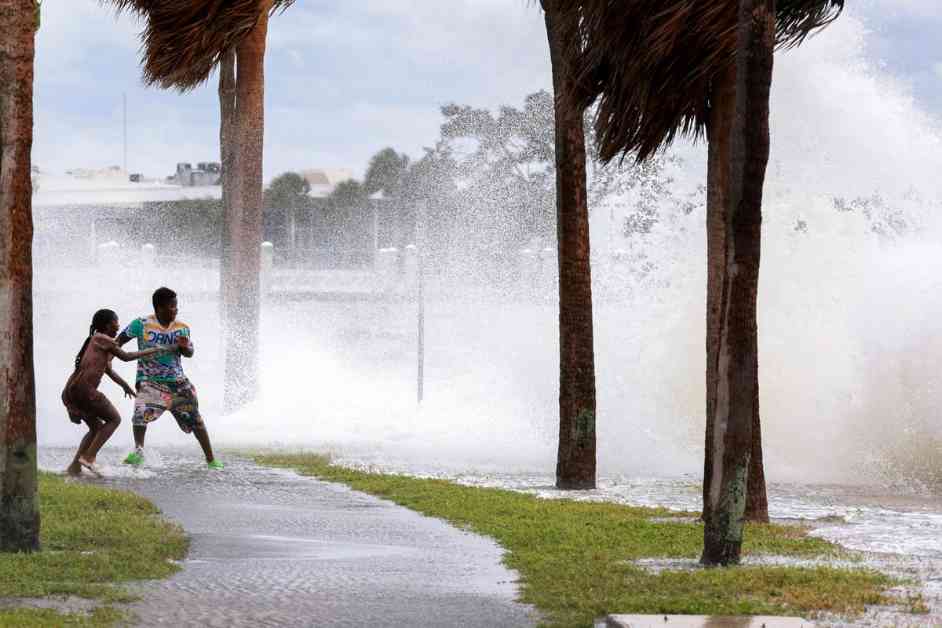Understanding Hurricane Categories: Hurricane Helene Strikes Florida
Hurricane Helene, a category 4 storm, made landfall in north-west Florida with devastating force, prompting forecasters to issue warnings of a catastrophic storm surge. As of 11.10pm local time on Thursday, the National Hurricane Centre in Miami reported that Helene was nearing the mouth of the Aucilla River in the Big Bend region of Florida’s Gulf Coast. The weather service cautioned residents about the potential for flash floods and winds exceeding 140mph (225 km/h). In addition to Florida, warnings of hurricanes and flash floods were also issued for northern Georgia and western North Carolina.
On the tracking website poweroutage.us, staggering numbers were reported – over 1.2 million households and businesses without power in Florida, over 500,000 in Georgia, and over 30,000 in the Carolinas. Tragically, Florida Governor Ron DeSantis confirmed a fatality as a result of the storm, where a person lost their life when a sign fell on their automobile while travelling on a motorway.
Governor DeSantis expressed grave concerns for the aftermath of the storm, stating, “When Floridians wake up tomorrow morning, we’re going to be waking up to a state where, very likely, there’s been additional loss of life. And certainly, there’s going to be loss of property. You’re going to have people that are going to lose their homes because of this storm. So please keep those folks in mind, keep them in your prayers.”
As Hurricane Helene wreaked havoc, reports emerged of two additional fatalities from a potential tornado in nearby Georgia, as reported by the Associated Press. Meanwhile, officials in rural Taylor County, Florida, offered a chilling piece of advice to those who chose not to evacuate. The sheriff’s office urged residents to write their name, birthday, and important information on their arm or leg in a permanent marker to facilitate identification and notification of family members in case of emergencies.
What are the Hurricane Categories?
Hurricanes are categorized based on the severity of their wind speed, ranging from category 1 to category 5. It’s important to note that these categories solely focus on wind speed and do not consider other potential hazards like rainfall, flooding, or tornadoes. Here’s a breakdown of the five hurricane categories and their implications:
– **Category 1 (max sustained winds of 74mph-95mph)**
– Winds with speeds between 74mph and 95mph can cause damage to property, including roofs, shingles, vinyl siding, and gutters in well-built homes. Large branches are likely to snap, and trees with shallow roots may fall. Extensive damage to power lines and poles can lead to power outages lasting several days.
– **Category 2 (max sustained winds of 96mph-110mph)**
– Winds ranging from 96mph to 110mph are extremely dangerous and can result in major roof and siding damage to buildings. Many trees with shallow roots may fall, potentially blocking roads. Power outages are expected, with total blackouts lasting from several days to weeks.
– **Category 3 (max sustained winds of 111mph-129mph)**
– Wind speeds between 111mph and 129mph can cause devastating damage, including major structural damage to buildings and removal of roof decking and gable ends. Numerous trees are likely to fall, obstructing roads, while electricity and water services may be unavailable for several days to weeks post-storm.
– **Category 4 (max sustained winds of 130mph-156mph)**
– Catastrophic damage is anticipated from winds with speeds of 130mph to 156mph, leading to severe damage to buildings such as roof structure loss and exterior wall destruction. Most trees will be snapped or uprooted, power poles will be downed, and residential areas may be isolated. Power outages could persist for weeks to months, rendering the area uninhabitable.
– **Category 5 (max sustained winds of 157mph or higher)**
– Wind speeds exceeding 157mph are catastrophic, resulting in the destruction of a high percentage of homes with total roof failure and wall collapse. Fallen trees and power poles can isolate residential areas, and power outages may last for weeks to possibly months. The affected area is likely to be uninhabitable for an extended period.
As Hurricane Helene continues to impact Florida and neighboring states, it serves as a stark reminder of the destructive potential of these natural disasters. Residents are urged to heed evacuation orders, prepare emergency kits, and stay informed through official channels to ensure their safety during such extreme weather events.












